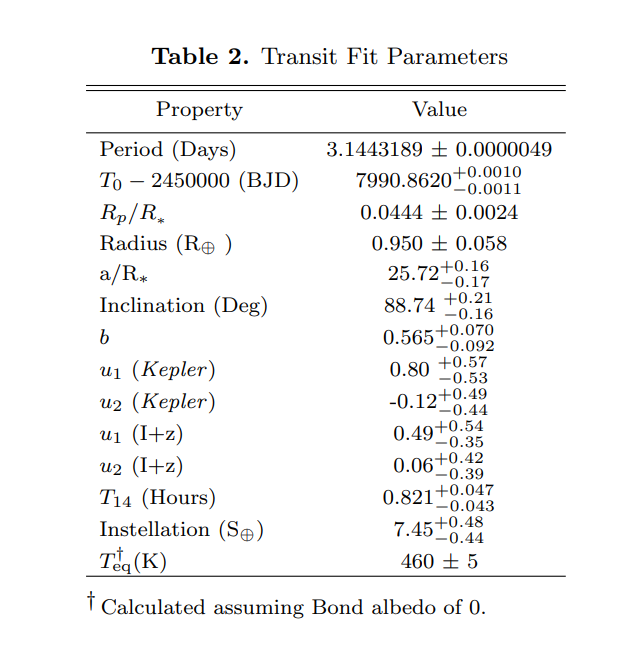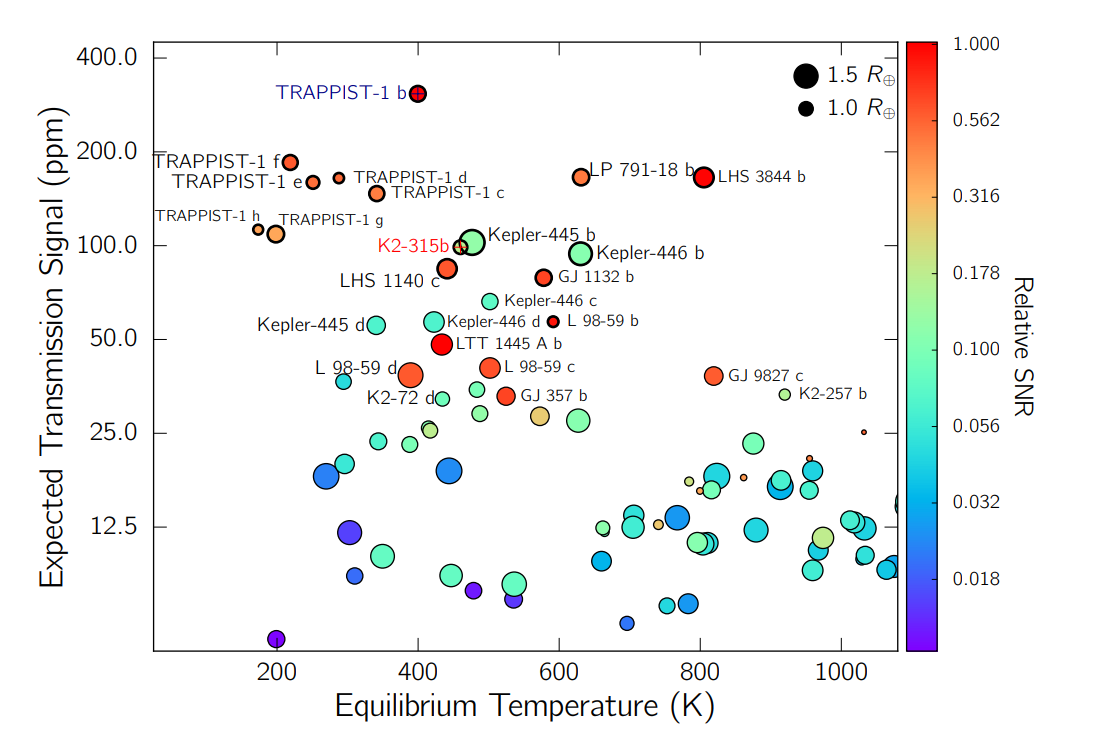This paper is available on arxiv under CC 4.0 license.
Authors:
(1) Prajwal Niraula, Department of Earth, Atmospheric and Planetary Sciences;
(2) Julien de Wit, Department of Earth, Atmospheric and Planetary Sciences;
(3) Benjamin V. Rackham, Department of Earth, Atmospheric and Planetary Sciences;
(4) Elsa Ducrot, Astrobiology Research Unit, University of Li`ege;
(5) Artem Burdanov, Department of Earth, Atmospheric and Planetary Sciences;
(6) Ian J. M. Crossfield, Kansas University Department of Physics and Astronomy;
(7) Valerie Van Grootel´, Space Sciences, Technologies and Astrophysics Research (STAR) Institute, University of Li`ege;
(8) Catriona Murray, 5Cavendish Laboratory;
(9) Lionel J. Garcia, Astrobiology Research Unit, University of Li`ege;
(10) Roi Alonso, Instituto de Astrof´ısica de Canarias & Dpto. de Astrof´ısica, Universidad de La Laguna;
(11) Corey Beard, Department of Physics & Astronomy, The University of California;
(12) Yilen Gomez Maqueo Chew, Instituto de Astronom´ıa, Universidad Nacional Aut´onoma de M´exico, Ciudad Universitaria;
(13) Laetitia Delrez, Astrobiology Research Unit, University of Li`ege, Space Sciences, Technologies and Astrophysics Research (STAR) Institute, University of Li`ege & 0Observatoire de lUniversit´e de Gen`eve;
(14) Brice-Olivier Demory, University of Bern, Center for Space and Habitability;
(15) Benjamin J. Fulton, NASA Exoplanet Science Institute/Caltech-IPAC;
(16) Michael Gillon, Astrobiology Research Unit, University of Li`ege;
(17) Maximilian N. Gunther, Department of Physics, and Kavli Institute for Astrophysics and Space Research, Massachusetts Institute of Technology;
(18) Andrew W. Howard, California Institute of Technology;
(19) Howard Issacson, Department of Astronomy, University of California Berkeley;
(20) Emmanuel Jehin, Space Sciences, Technologies and Astrophysics Research (STAR) Institute, University of Li`ege;
(21) Peter P. Pedersen, Cavendish Laboratory;
(22) Francisco J. Pozuelos, Astrobiology Research Unit, University of Li`ege & Space Sciences, Technologies and Astrophysics Research (STAR) Institute, University of Li`ege;
(23) Didier Queloz, Cavendish Laboratory;
(24) Rafael Rebolo-Lopez, Instituto de Astrof´ısica de Canarias & Dpto. de Astrof´ısica, Universidad de La Laguna';
(25) Sairam Lalitha, School of Physics & Astronomy, University of Birmingham;
(26) Daniel Sebastian, Astrobiology Research Unit, University of Li`ege
(27) Samantha Thompson, Cavendish Laboratory;
(28) Amaury H.M.J. Triaud, School of Physics & Astronomy, University of Birmingham.
Table of Links
4. FUTURE PROSPECTS

The search for transiting planets around small stars has been motivated in large part by their potential for atmospheric characterization. Owing to the size and proximity of its host, K2-315b is thus one of the few known terrestrial exoplanets possibly amenable for atmospheric characterization in the next two decades. In order to quantify and contextualize its prospects for atmospheric study, we followed the same approach as for TRAPPIST-1 in Gillon et al. (2016) (see de Wit & Seager 2013), focusing here on all known terrestrial planets. We selected terrestrial planets as planets with a reported radius below 1.6 R⊕ in the NASA Exoplanet Archive[4] (Rogers 2015; Fulton et al. 2017). We thus derive the amplitude of the planets’ signals in transmission as:

where Rp is the planetary radius, R∗ is the stellar radius, and heff is the effective atmospheric height, µ is the atmospheric mean molecular mass, T is the atmospheric temperature and g is the local gravity. We assume heff to cover seven atmospheric scale heights, µ the atmospheric mean molecular mass to be 20 amu, and the atmospheric temperature to be the equilibrium temperature for a Bond albedo of 0. For the planets with missing masses, we estimated g using the model of Chen & Kipping (2017).

The signal amplitudes are reported in Figure 7 together with the SNR relative to TRAPPIST-1 b’s, calculated by scaling the signal amplitude with the hosts’ brightness in J band. We find that K2-315b fares closely to the outer planets of TRAPPIST-1 in terms of potential for atmospheric exploration with JWST— its warmer and thus larger atmosphere compensating for its larger star. In fact, its relative SNR for transmission spectroscopy is half those of TRAPPIST-1 f–h, meaning that assessing the presence of a µ ∼ 20 atmosphere around the planet would require of the order of 40 transits—four times the ∼10 transits required for a similar assessment for TRAPPIST-1 f–h (Lustig-Yaeger et al. 2019). K2-315b is thus at the very edge of JWST’s capability for atmospheric characterization, mostly due to its “large” host star. The derivation above allows us to rank planets in terms of relative potential for atmospheric characterization, assuming a similar atmospheric scenario. In practice, a significant difference in atmospheric mean molecular mass, surface pressure, and/or cloud/haze altitude will strongly affect the actual potential of a planet for characterization (Lustig-Yaeger et al. 2019). For example, in some cases clouds could render the characterization of the favorable TRAPPIST-1 e difficult even with the generation of instruments following the JWST (i.e., LUVOIR, Pidhorodetska et al. 2020).
With an estimated radial velocity semi-amplitude of 1.3 m s−1 (assuming a mass comparable to that of Earth), the planet could be accessible for mass measurements using modern ultra-precise radial velocity instruments. Such possibilities and a ranking amongst the 10 best-suited Earth-sized planets for atmospheric study, EPIC 249631677 b will therefore play an important role in the upcoming era of comparative exoplanetology for terrestrial worlds. It will surely be a prime target for the generation of observatories to follow JWST and bring the field fully into this new era.
Acknowledgments: This project makes use of publicly available K2 data. P.N. would like to acknowledge funding for Kerr Fellowship and Elliot Fellowship at MIT. J.d.W. and MIT gratefully acknowledge financial support from the Heising-Simons Foundation, Dr. and Mrs. Colin Masson and Dr. Peter A. Gilman for Artemis, the first telescope of the SPECULOOS network situated in Tenerife, Spain. B.V.R. thanks the Heising-Simons Foundation for support. V.V.G. is a F.R.S.-FNRS Research Associate. M.G. and E.J. are F.R.S.-FNRS Senior Research Associates. This work was also partially supported by a grant from the Simons Foundation (PI Queloz, grant number 327127), and funding from the European Research Council under the European Union’s Seventh Framework Programme (FP/2007-2013) ERC Grant Agreement Number 336480, from the ARC grant for Concerted Research Actions financed by the Wallonia-Brussels Federation, from the Balzan Prize Foundation, from F.R.S-FNRS (Research Project ID T010920F), from the European Research Council (ERC) under the European Unions Horizon 2020 research and innovation programme (grant agreement n◦ 803193/BEBOP), and from a Leverhulme Trust Research Project Grant n◦ RPG-2018-418.
Facilities: Keck:I (HIRES), Kepler, MAST (HLSP, K2), SNO, SSO
Software: astropy (Astropy Collaboration et al. 2013, 2018), batman (Kreidberg 2015), emcee (Foreman-Mackey et al. 2013), isochrones (Morton 2015), prose (Garcia et al. in prep.), SPOCK (Sebastian et al. in prep.), transitleastsquares (Hippke & Heller 2019), w¯otan (Hippke et al. 2019)
REFERENCES
Allard, F., Homeier, D., & Freytag, B. 2012, Philosophical Transactions of the Royal Society of London Series A, 370, 2765, doi: 10.1098/rsta.2011.0269
Astropy Collaboration, Robitaille, T. P., Tollerud, E. J., et al. 2013, A&A, 558, A33, doi: 10.1051/0004-6361/201322068
Astropy Collaboration, Price-Whelan, A. M., Sip˝ocz, B. M., et al. 2018, AJ, 156, 123, doi: 10.3847/1538-3881/aabc4f
Bensby, T., Feltzing, S., & Oey, M. S. 2014, A&A, 562, A71, doi: 10.1051/0004-6361/201322631
Borucki, W. J., Koch, D., Basri, G., et al. 2010, Science, 327, 977, doi: 10.1126/science.1185402
Buchner, J., Georgakakis, A., Nandra, K., et al. 2014, A&A, 564, A125, doi: 10.1051/0004-6361/201322971
Burdanov, A., Delrez, L., Gillon, M., & Jehin, E. 2018, SPECULOOS Exoplanet Search and Its Prototype on TRAPPIST, 130, doi: 10.1007/978-3-319-55333-7 130
Chen, J., & Kipping, D. 2017, ApJ, 834, 17, doi: 10.3847/1538-4357/834/1/17
Choi, J., Dotter, A., Conroy, C., et al. 2016, ApJ, 823, 102, doi: 10.3847/0004-637X/823/2/102
Christiansen, J. L., Crossfield, I. J. M., Barentsen, G., et al. 2018, AJ, 155, 57, doi: 10.3847/1538-3881/aa9be0
Chubak, C., Marcy, G., Fischer, D. A., et al. 2012, arXiv e-prints. https://arxiv.org/abs/1207.6212
Cutri, R. M., Skrutskie, M. F., van Dyk, S., et al. 2003, VizieR Online Data Catalog, II/246 Cutri et al., R. M. 2013, VizieR Online Data Catalog, II/328 de Wit, J., & Seager, S. 2013, Science, 342, 1473, doi: 10.1126/science.1245450
Delrez, L., Gillon, M., Queloz, D., et al. 2018, in Society of Photo-Optical Instrumentation Engineers (SPIE) Conference Series, Vol. 10700, Proc. SPIE, 107001I, doi: 10.1117/12.2312475
Dotter, A. 2016, ApJS, 222, 8, doi: 10.3847/0067-0049/222/1/8
Dressing, C. D., & Charbonneau, D. 2013, ApJ, 767, 95, doi: 10.1088/0004-637X/767/1/95
Esselstein, R., Aigrain, S., Vanderburg, A., et al. 2018, ApJ, 859, 167, doi: 10.3847/1538-4357/aac20e
Fernandes, C. S., Van Grootel, V., Salmon, S. J. A. J., et al. 2019, ApJ, 879, 94, doi: 10.3847/1538-4357/ab2333
Feroz, F., Hobson, M. P., & Bridges, M. 2009, MNRAS, 398, 1601, doi: 10.1111/j.1365-2966.2009.14548.x
Foreman-Mackey, D., Hogg, D. W., Lang, D., & Goodman, J. 2013, PASP, 125, 306, doi: 10.1086/670067
Fressin, F., Torres, G., Charbonneau, D., et al. 2013, ApJ, 766, 81, doi: 10.1088/0004-637X/766/2/81
Fulton, B. J., Petigura, E. A., Howard, A. W., et al. 2017, AJ, 154, 109, doi: 10.3847/1538-3881/aa80eb
Gaia Collaboration, Brown, A. G. A., Vallenari, A., et al. 2018, A&A, 616, A1, doi: 10.1051/0004-6361/201833051
Garcia, L. J., Gillon, M., & SPECULOOS. in prep. Gillon, M., Jehin, E., Fumel, A., Magain, P., & Queloz, D. 2013, in European Physical Journal Web of Conferences, Vol. 47, European Physical Journal Web of Conferences, 03001, doi: 10.1051/epjconf/20134703001
Gillon, M., Jehin, E., Lederer, S. M., et al. 2016, Nature, 533, 221, doi: 10.1038/nature17448
Gillon, M., Triaud, A. H. M. J., Demory, B.-O., et al. 2017, Nature, 542, 456, doi: 10.1038/nature21360
Gillon, M., Meadows, V., Agol, E., et al. 2020, arXiv e-prints, arXiv:2002.04798. https://arxiv.org/abs/2002.04798
Goldreich, P., & Soter, S. 1966, Icarus, 5, 375, doi: 10.1016/0019-1035(66)90051-0
G¨unther, M. N., Pozuelos, F. J., Dittmann, J. A., et al. 2019, Nature Astronomy, 3, 1099, doi: 10.1038/s41550-019-0845-5
G¨unther, M. N., Zhan, Z., Seager, S., et al. 2020, AJ, 159, 60, doi: 10.3847/1538-3881/ab5d3a
Hardegree-Ullman, K. K., Cushing, M. C., Muirhead, P. S., & Christiansen, J. L. 2019, AJ, 158, 75, doi: 10.3847/1538-3881/ab21d2
Hippke, M., David, T. J., Mulders, G. D., & Heller, R. 2019, AJ, 158, 143, doi: 10.3847/1538-3881/ab3984
Hippke, M., & Heller, R. 2019, A&A, 623, A39, doi: 10.1051/0004-6361/201834672
Howard, A. W., Johnson, J. A., Marcy, G. W., et al. 2010, ApJ, 721, 1467, doi: 10.1088/0004-637X/721/2/1467
Howell, S. B., Sobeck, C., Haas, M., et al. 2014, PASP, 126, 398, doi: 10.1086/676406
Huber, D., Bryson, S. T., Haas, M. R., et al. 2016, ApJS, 224, 2, doi: 10.3847/0067-0049/224/1/2
Ilin, E., Schmidt, S. J., Davenport, J. R. A., & Strassmeier, K. G. 2019, A&A, 622, A133, doi: 10.1051/0004-6361/201834400
Jao, W.-C., Henry, T. J., Gies, D. R., & Hambly, N. C. 2018, ApJL, 861, L11, doi: 10.3847/2041-8213/aacdf6
Jehin, E., Gillon, M., Queloz, D., et al. 2018, The Messenger, 174, 2, doi: 10.18727/0722-6691/5105
Kass, R. E., & Raftery, A. E. 1995, Journal of the American Statistical Association, 90, 773 Kipping, D. M. 2013, MNRAS, 435, 2152, doi: 10.1093/mnras/stt1435
Kolbl, R., Marcy, G. W., Isaacson, H., & Howard, A. W. 2015, AJ, 149, 18, doi: 10.1088/0004-6256/149/1/18
Kostov, V. B., Schlieder, J. E., Barclay, T., et al. 2019, AJ, 158, 32, doi: 10.3847/1538-3881/ab2459
Kreidberg, L. 2015, PASP, 127, 1161, doi: 10.1086/683602
Lasker, B. M., Sturch, C. R., McLean, B. J., et al. 1990, AJ, 99, 2019, doi: 10.1086/115483
Luger, R., Agol, E., Kruse, E., et al. 2016, AJ, 152, 100, doi: 10.3847/0004-6256/152/4/100
Lustig-Yaeger, J., Meadows, V. S., & Lincowski, A. P. 2019, AJ, 158, 27, doi: 10.3847/1538-3881/ab21e0
Mann, A. W., Dupuy, T., Kraus, A. L., et al. 2019, ApJ, 871, 63, doi: 10.3847/1538-4357/aaf3bc
Morris, S. L. 1985, ApJ, 295, 143, doi: 10.1086/163359
Morton, T. D. 2015, isochrones: Stellar model grid package. http://ascl.net/1503.010
Mulders, G. D., Pascucci, I., & Apai, D. 2015, ApJ, 814, 130, doi: 10.1088/0004-637X/814/2/130
Murray, C. A., Delrez, L., Pedersen, P. P., et al. 2020, MNRAS, 495, 2446, doi: 10.1093/mnras/staa1283
Niraula, P., Redfield, S., de Wit, J., et al. 2018, arXiv e-prints, arXiv:1812.09227. https://arxiv.org/abs/1812.09227
Niraula, P., Redfield, S., Dai, F., et al. 2017, AJ, 154, 266, doi: 10.3847/1538-3881/aa957c
Ochsenbein, F., Bauer, P., & Marcout, J. 2000, A&AS, 143, 23, doi: 10.1051/aas:2000169
Patra, K. C., Winn, J. N., Holman, M. J., et al. 2017, AJ, 154, 4, doi: 10.3847/1538-3881/aa6d75
Paxton, B., Bildsten, L., Dotter, A., et al. 2011, ApJS, 192, 3, doi: 10.1088/0067-0049/192/1/3
Paxton, B., Cantiello, M., Arras, P., et al. 2013, ApJS, 208, 4, doi: 10.1088/0067-0049/208/1/4
Paxton, B., Marchant, P., Schwab, J., et al. 2015, ApJS, 220, 15, doi: 10.1088/0067-0049/220/1/15
Pidhorodetska, D., Fauchez, T., Villanueva, G., Domagal-Goldman, S., & Kopparapu, R. K. 2020, arXiv e-prints, arXiv:2001.01338. https://arxiv.org/abs/2001.01338
Quinn, S. N., Becker, J. C., Rodriguez, J. E., et al. 2019, AJ, 158, 177, doi: 10.3847/1538-3881/ab3f2b
Rabus, M., Lachaume, R., Jord´an, A., et al. 2019, MNRAS, 484, 2674, doi: 10.1093/mnras/sty3430
Reid, I. N., Brewer, C., Brucato, R. J., et al. 1991, PASP, 103, 661, doi: 10.1086/132866
Reiners, A., Joshi, N., & Goldman, B. 2012, AJ, 143, 93, doi: 10.1088/0004-6256/143/4/93
Rodriguez, D. 2016, Dr-Rodriguez/Kinematics-App: Stellar Kinematics V1.0, v1.0, Zenodo, doi: 10.5281/zenodo.192159
Rodriguez, J. E., Vanderburg, A., Eastman, J. D., et al. 2018, AJ, 155, 72, doi: 10.3847/1538-3881/aaa292
Rogers, L. A. 2015, ApJ, 801, 41, doi: 10.1088/0004-637X/801/1/41
Seager, S., & Mall´en-Ornelas, G. 2003, ApJ, 585, 1038, doi: 10.1086/346105
Sebastian, D., Gillon, M., & SPECULOOS. in prep. Stassun, K. G., & Torres, G. 2018, ApJ, 862, 61, doi: 10.3847/1538-4357/aacafc
Stassun, K. G., Oelkers, R. J., Paegert, M., et al. 2019, AJ, 158, 138, doi: 10.3847/1538-3881/ab3467
Van Grootel, V., Fernandes, C. S., Gillon, M., et al. 2018, ApJ, 853, 30, doi: 10.3847/1538-4357/aaa023
Vanderburg, A., & Johnson, J. A. 2014, PASP, 126, 948, doi: 10.1086/678764
Vanderburg, A., Johnson, J. A., Rappaport, S., et al. 2015, Nature, 526, 546, doi: 10.1038/nature15527
Vogt, S. S., Allen, S. L., Bigelow, B. C., et al. 1994, in Proc. SPIE, Vol. 2198, Instrumentation in Astronomy VIII, ed. D. L. Crawford & E. R. Craine, 362
Winn, J. N. 2010, Exoplanet Transits and Occultations, ed. S. Seager, 55–77
Yee, S. W., Petigura, E. A., & von Braun, K. 2017, ArXiv e-prints. https://arxiv.org/abs/1701.00922
[4] https://exoplanetarchive.ipac.caltech.edu

